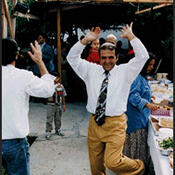 The eight day harvest festival of Sukkot commemorates the Jews’ forty years of wandering in the desert after their exodus from Egypt, as described in the Torah. Jews build sukkahs, temporary structures made of organic materials like bamboo and leaves in backyards, yards, or rooftops. Jews then eat meals—and, for some, sleep—in the structures. Shemini Atzeret is the eighth day of Sukkot. Simchat Torah, the following day, celebrates the congregation’s yearly completion of the reading of the whole Torah, finishing the Book of Deuteronomy and beginning again with Genesis.... Read more about Sukkot, Shemini Atzeret, and Simchat Torah
The eight day harvest festival of Sukkot commemorates the Jews’ forty years of wandering in the desert after their exodus from Egypt, as described in the Torah. Jews build sukkahs, temporary structures made of organic materials like bamboo and leaves in backyards, yards, or rooftops. Jews then eat meals—and, for some, sleep—in the structures. Shemini Atzeret is the eighth day of Sukkot. Simchat Torah, the following day, celebrates the congregation’s yearly completion of the reading of the whole Torah, finishing the Book of Deuteronomy and beginning again with Genesis.... Read more about Sukkot, Shemini Atzeret, and Simchat Torah